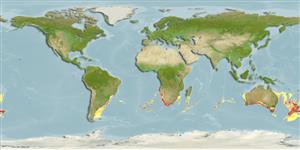Environment: milieu / climate zone / intervalo de profundidade / distribution range
Ecologia
marinhas bentopelágico; intervalo de profundidade 40 - 1500 m (Ref. 52180), usually 260 - 490 m (Ref. 52180). Deep-water; 19°S - 55°S, 67°W - 173°W
Southwest Atlantic: Argentina. Southeast Atlantic and Western Indian Ocean: South Africa. Southwest Pacific: New Zealand and Australia (including Western Australia).
Length at first maturity / Tamanho / Peso / Idade
Maturidade: Lm 70.6, range 59 - ? cm
Max length : 140 cm TL macho/indeterminado; (Ref. 9563); common length : 60.0 cm TL macho/indeterminado; (Ref. 52180); peso máx. Publicado: 63.0 kg (Ref. 54802); Idade máx. registada: 15 anos (Ref. 9072)
Descrição breve
Chaves de identificação | Morfologia | Morfometria
Espinhos dorsais (total) : 7 - 8; Raios dorsais moles (total) : 19 - 21; Espinhos anais: 3; Raios anais moles: 15 - 17. Uniformly dark to black.
Body shape (shape guide): fusiform / normal.
Most common over or near rocky areas at 100-300 m (Ref. 9258). Generally, blue eye remain close to the sea bed during the day and move up in the water column at night, following concentrations of food (Ref. 6390). The fish are found over rough ground and at the edges of canyons and steep drop-offs. Blue eye appear to prefer cold water as part of their general behavior (Ref. 6390). Juveniles inhabit surface waters, sometimes in association with floating debris (Ref. 6390). Feed primarily on the pelagic tunicate Pyrosoma atlantica which is found near the sea bed during the day but dispersed throughout the water column at night (Ref. 7129, 30454). They also feed on squid, mollusks and crustaceans (Ref. 30455, 30454) and fish ranging from small lanternfish (Myctophidae) to large fish such as gemfish (Rexea solandri). Juveniles consume small planktonic and sedentary organisms (Ref. 30456). Marketed fresh and frozen; exported to Japan for sashimi; eaten steamed, fried, broiled and baked (Ref. 9988).
In Australia, spawning appears to be correlated with water temperature and nutrient upwellings (Ref. 7129). It appears that mature fish move up the continental slope into shallow depths (320-400 m) and aggregate in specific grounds for spawning (Ref. 6390).
There is no information on the number of eggs blue eye produce nor on the egg and larval stages of their life history (Ref. 6390).
Haedrich, R.L., 1986. Stromateidae. p. 842-846. In M.M. Smith and P.C. Heemstra (eds.) Smiths' sea fishes. Springer-Verlag, Berlin. (Ref. 4410)
Categoria na Lista Vermelha da IUCN (Ref. 130435: Version 2025-1)
Ameaça para o homem
Harmless
Utilização humana
Pescarias: espécies comerciais
Ferramentas
Relatórios especiais
Descarregue XML
Fontes da internet
Estimates based on models
Preferred temperature (Ref.
123201): 4.1 - 16.4, mean 7.5 °C (based on 485 cells).
Phylogenetic diversity index (Ref.
82804): PD
50 = 0.5156 [Uniqueness, from 0.5 = low to 2.0 = high].
Bayesian length-weight: a=0.00891 (0.00498 - 0.01595), b=3.10 (2.94 - 3.26), in cm total length, based on LWR estimates for this species & (Sub)family-body (Ref.
93245).
Nível Trófico (Ref.
69278): 4.0 ±0.57 se; based on food items.
Resiliência (Ref.
120179): Médio, tempo mínimo de duplicação da população 1,4 - 4,4 anos (K=0.03-0.3; tm=5-7; tmax=15).
Prior r = 0.57, 95% CL = 0.38 - 0.86, Based on 3 data-limited stock assessments.
Fishing Vulnerability (Ref.
59153): Moderate to high vulnerability (51 of 100).
🛈
Climate Vulnerability (Ref.
125649): Moderate to high vulnerability (52 of 100).
🛈
Nutrients (Ref.
124155): Calcium = 10.4 [6.4, 22.4] mg/100g; Iron = 0.339 [0.162, 0.644] mg/100g; Protein = 18.3 [15.8, 20.3] %; Omega3 = 0.374 [0.208, 0.689] g/100g; Selenium = 30.4 [12.7, 67.0] μg/100g; VitaminA = 10.3 [2.3, 43.0] μg/100g; Zinc = 0.259 [0.181, 0.392] mg/100g (wet weight); based on
nutrient studies.
